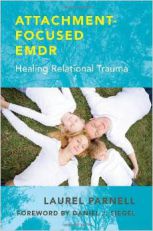E.M.D.R.®
Trauma therapy according to Francine Shapiro Ph.D.
How does EMDR® work?
E.M.D.R. stands for 'Eye Movement Desensitization and Reprocessing'.
Using the left-right movement of the eyes, anxiety and fears can be reduced – they can be desensitized.
In addition to that, the left-right stimulation of the brain enables a link-up of the previously isolated and stored part of the memory. The dissociated emotions, body reactions and sense
impressions again become part of the normal memory. This reprocessing has the effect that the traumatic experience in fact still exists in the memory, but it is not constantly present, nor does
it carry a charge.
Many clients know after a few EMDR sessions that something severe happened in the past but it is no longer important and life can now move on.
For the treatment of post-traumatic stress disorder (PTSD) EMDR is internationally recognized as a scientifically proven method.
What exactly happens in an EMDR® session?
As a general rule, one specific, particularly burdening phase of the trauma experience will be selected and used as a starting point. It will be ascertained which body sensations and which emotions are produced when the client puts himself in the position of the trauma experience and which negative beliefs are formed because of this situation.
In the beginning, the founder of this method, Francine Shapiro, had used the eye movements as a standard bilateral stimulation. Since then we have learnt that other forms of bilateral
stimulations e.g. tapping on the knees and acoustic or other impulses are just as effective. During the course of the session the client reports what has changed and what he perceives. This kind
of processing can go on for up to an hour. Normally, a typical wavelike sequence occurs alternating between negative and positive perceptions and memories.
The therapist steers the session and ensures that the client is not overwhelmed and the work happens in the context of safety, protection and support.
Which disorders can EMDR® treat?
• Partnership problems – Mostly the causes lie in the childhood and in the relationship with the parents or the caregivers.
• Depressive disposition – In a life-threatening situation we react with either fight or flight and, when neither assault nor escape is possible (and for children this is often the case), with
freeze. In this condition our feelings go away and it is as if our soul has separated from our body.
• Fears and phobias – The origin of the fear lies in the past and during the reprocessing the remembrance of this situation can come up.
• Sleep disorders – With severe shock the whole nervous system can land in a state of red alert and then years later this does not permit a peaceful sleep.
• Physical symptoms without organic causes – When one cannot speak, the body speaks. Unresolved conflicts are not just in the brain but also stored in the body.
Free preliminary talk
Call now for a 30 min.
free initial consultation over the phone
or video conference!
Tel: 02205 - 89 45 405
or
Appointments at short notice are possible!
_________________________
Practice in Cologne (Köln)
Practice room in UTA Institut
Venloerstr. 5-7
50672 Köln
Practice in Rösrath
Zum Sandfeld 2b
51503 Rösrath
» Route
Quote
to mean there is nothing they can do about their unhappiness.
Everyday fears can range from minor anxieties to an intense fear of things that can often be avoided, like snakes or spiders.
But generally people enter therapy when life has become unmanageable -- when they can't ignore the level of emotional pain they are experiencing.«
- Francine Shapiro -
Book recommendation:
Attachment focused EMDR
Healing Relational Trauma
Laurel Parnell
Norton & Company, ISBN-10: 03937074

